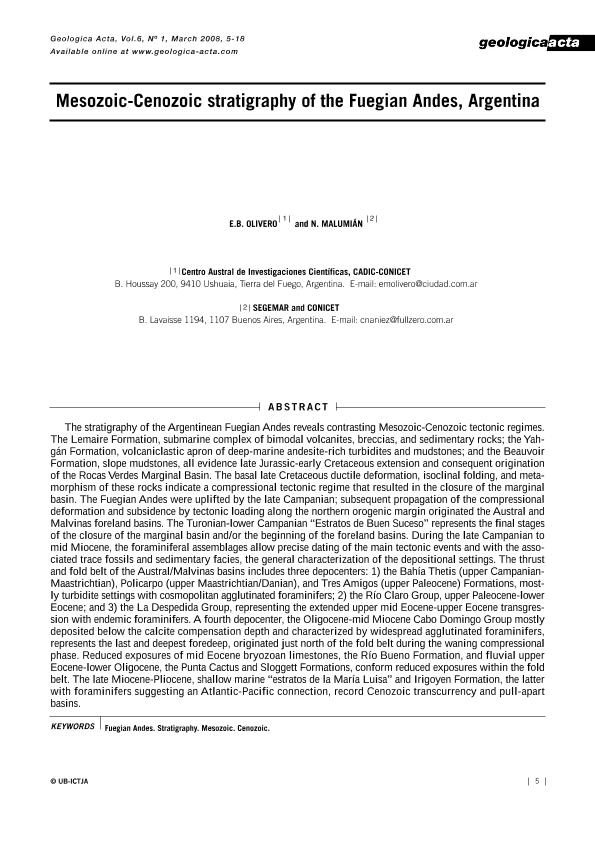Artículo
Mesozoic-Cenozoic stratigraphy of the Fuegian Andes, Argentina
Fecha de publicación:
26/03/2008
Editorial:
Universidad de Barcelona
Revista:
Geologica Acta
ISSN:
1695-6133
Idioma:
Inglés
Tipo de recurso:
Artículo publicado
Clasificación temática:
Resumen
The stratigraphy of the Argentinean Fuegian Andes reveals contrasting Mesozoic-Cenozoic tectonic regimes. The Lemaire Formation, submarine complex of bimodal volcanites, breccias, and sedimentary rocks; the Yahgán Formation, volcaniclastic apron of deep-marine andesite-rich turbidites and mudstones; and the Beauvoir Formation, slope mudstones, all evidence late Jurassic early Cretaceous extension and consequent origination of the Rocas Verdes Marginal Basin. The basal late Cretaceous ductile deformation, isoclinal folding, and metamorphism of these rocks indicate a compressional tectonic regime that resulted in the closure of the marginal basin. The Fuegian Andes were uplifted by the late Campanian; subsequent propagation of the compressional deformation and subsidence by tectonic loading along the northern orogenic margin originated the Austral and Malvinas foreland basins. The Turonian-lower Campanian “Estratos de Buen Suceso” represents the final stages of the closure of the marginal basin and/or the beginning of the foreland basins. During the late Campanian to mid Miocene, the foraminiferal assemblages allow precise dating of the main tectonic events and with the associated trace fossils and sedimentary facies, the general characterization of the depositional settings. The thrust and fold belt of the Austral/Malvinas basins includes three depocenters: 1) the Bahía Thetis (upper Campanian-Maastrichtian), Policarpo (upper Maastrichtian/Danian), and Tres Amigos (upper Paleocene) Formations, mostly turbidite settings with cosmopolitan agglutinated foraminifers; 2) the Río Claro Group, upper Paleocene-lower Eocene; and 3) the La Despedida Group, representing the extended upper mid Eocene-upper Eocene transgression with endemic foraminifers. A fourth depocenter, the Oligocene-mid Miocene Cabo Domingo Group mostly deposited below the calcite compensation depth and characterized by widespread agglutinated foraminifers, represents the last and deepest foredeep, originated just north of the fold belt during the waning compressional phase. Reduced exposures of mid Eocene bryozoan limestones, the Río Bueno Formation, and fluvial upper Eocene lower Oligocene, the Punta Cactus and Sloggett Formations, conform reduced exposures within the fold belt. The late Miocene-Pliocene, shallow marine “estratos de la María Luisa” and Irigoyen Formation, the latter with foraminifers suggesting an Atlantic-Pacific connection, record Cenozoic transcurrency and pull-apart basins.
Palabras clave:
FUEGIAN ANDES
,
STRATIGRAPHY
,
MESOZOIC
,
CENOZOIC
Archivos asociados
Licencia
Identificadores
Colecciones
Articulos(CADIC)
Articulos de CENTRO AUSTRAL DE INVESTIGACIONES CIENTIFICAS
Articulos de CENTRO AUSTRAL DE INVESTIGACIONES CIENTIFICAS
Articulos(SEDE CENTRAL)
Articulos de SEDE CENTRAL
Articulos de SEDE CENTRAL
Citación
Olivero, Eduardo Bernardo; Malumian, Norberto; Mesozoic-Cenozoic stratigraphy of the Fuegian Andes, Argentina; Universidad de Barcelona; Geologica Acta; 6; 1; 26-3-2008; 5-18
Compartir




